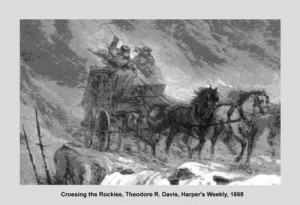Review by Chas Clifton
Snakebite – September 2008 – Colorado Central Magazine
Zero at the Bone – Rewriting Life after a Snakebite
by Erec Toso
Published in 2007 by University of Arizona Press
ISBN 0-8165-2591-9
WHEN I WAS BITTEN by a rattlesnake just outside Tucson, where writer Erec Toso lives, I spent two nights in the hospital, got rid of my crutches after a week, and was completely healed after a month.
Toso had a much rougher time, but he got a book out of it, one that uses the encounter with Crotalus scutulatus to talk about a number of larger issues, including the whole New West issue of living among sharp-toothed and/or venomous wildlife.
But the issue most important to him is how the bite and its aftermath changed his whole self-conception, his relationship to his family, and the way he thinks about his life.
Zero to the Bone is a trip into a personal inferno, the story of a man “in the middle of the road of my life,” to quote Dante, who awakes in an emergency room where the true way was wholly lost and who has to re-evaluate everything.
We meet Toso first off as trail runner, painter, U. of Arizona writing teacher, husband and dad, still cherishing romantic dreams: “Why, I wondered, had I caved into this life? … It had not been my vision to be a householding teacher, a worker bee…. I thought I should set up my life to be more free, maybe move to Montana and get a big dog, a sheepskin coat, and write muscular action novels about climbing mountains or running rivers, or outrunning and foiling the greedy corporate evildoers.”
Walking across his own front yard one evening, bringing his sons home from the community swimming pool, he is bitten: “As sophisticated as a syringe, the delivery system did its work. Then the snake rattled a dry leaves whir.”
And all his life “evaporated … I became little more than a piece of meat that was being digested by highly toxic enzymes, a body that soon could not work or walk and that was in the first round of a fight for its life. The fibers I wove together as a kind of shield to protect myself against the pains and threats of the world, both inside and out, unraveled, leaving me holding only threads, a searing vulnerability.”
And then the medical part begins, with Toso on the initiatory journey on the wings of venom and morphine. I know that one: at one point, as my gurney was wheeled down corridors from the emergency room to the ICU, the Tucson PD K-9 officer walking ahead of us turned into a full-blown Guardian of the Underworld.
Toso had the additional misfortune of contracting a secondary infection– all snakebites leave bacteria behind, bacteria deposited by the last defecation of their prey on its way down the snake’s gullet. Sent home in a wheelchair after four days in the hospital, Toso has barely started to catch up on the new semester, when an infected abscess sends him back to the emergency room.
As the medical story progresses, however, what interests Toso the writer is the snake story — how one culture treats them as holy, while another wants to kill them on sight. As Southwesterners keep moving to the desert’s edge, snake encounters increase, and as a biologist whom he interviews remarks, “We need to reconfigure the stories we tell about snakes. The ones we have just don’t work when it comes time to share the desert.”
Meanwhile, Toso sees himself changing, becoming more mindful, less driven — changed. If you came for the scary rattlesnake story, you get it, including biochemistry and a little herpetology from the biologists, but this is more the story of a man coming to terms with his life as it is, not as it was fantasized.
Unlike some of his relatives, Toso is not out to rid the world of rattlesnakes. They make the world interesting, he says, forcing us to pay attention and keeping the rat population down. I can understand that attitude. Six weeks after my own bite I was driving with my brother-in-law on a gravel road outside Salida when I saw a rattler in the road. I pulled over, lifted it with a fishing-rod tube, and carried it out into the adjoining pasture where it would not get run over. He was surprised that I had bothered, but I said that I wasn’t mad at rattlesnakes in general.
When someone says to Toso, “You must hate these things,” meaning the snakes, he answers, “No, not really. I think about them a lot though.”
That too is the rattlesnake initiation.


